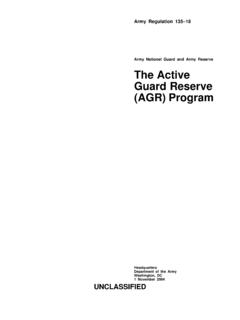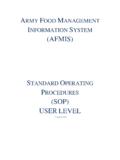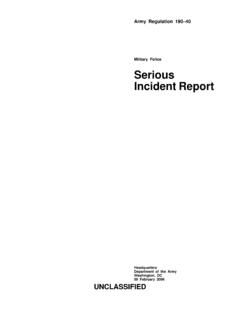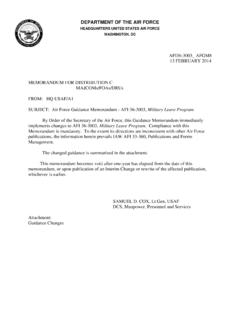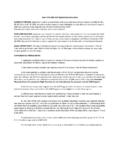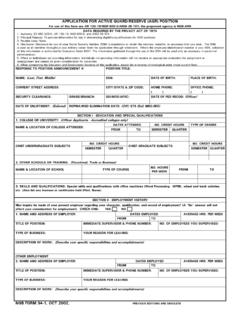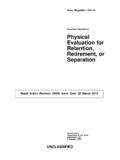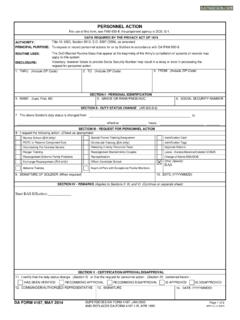Transcription of IDES GUIDEBOOK - Government of New York
1 IDES GUIDEBOOKAn Overview of the Integrated Disability Evaluation ARMY MEDICAL COMMAND July 2013 Integrated Disability Evaluation System GUIDEBOOK PURPOSE In 2007, the Department of Veterans Affairs (VA) and Department of Defense (DoD) received presidential direction to conduct a joint program to modernize and improve the disability evaluation and compensation process for wounded, ill, and injured Soldiers. VA and DoD collaborated to develop the Integrated Disability Evaluation System (IDES). The goals of IDES are to: Reduce the overall time it takes a Soldier to progress through the IDES process,starting at the time of referral to the Medical Evaluation Board (MEB) and endingupon receipt of VA benefits or return to duty (RTD); Utilize a single examination process that meets the needs of VA and DoD; and Increase transparency of both the military disability evaluation system and VAclaims processes for wounded, ill, and injured Soldiers and their IDES process identifies all medical and/or psychological conditions that impact military occupational function for the purposes of determining fitness for duty and entitlement to military and/ or VA disability compensation.
2 The core IDES process is standardized to ensure that each Soldier, Command, and the Army Staff understand their critical contributions to case processing. Accountability measures based on the minimum necessary standards are in place at all levels across the Arm y. This GUIDEBOOK clarifies the processes, roles and responsibilities, and standards measured at each IDES step. The IDES GUIDEBOOK is intended solely to provide MTFs and their personnel with a description of IDES practices and procedures. The IDES GUIDEBOOK should not be construed or referenced as an authoritative source for IDES regulations or policy. In-text citations refer to authoritative IDES policy and regulations. Readers should always seek out these authoritative sources when necessary and should not, in any case, cite to the IDES GUIDEBOOK as Department of the Army policy. This GUIDEBOOK will expire 1 July 2014. 1 In-text citations refer to authoritative IDES policy and regulations. Throughout this document hotlinks* are provided (curser should turn from an arrow to a hand*) that were functional at the time of publication.
3 Updates to remove/replace links, where appropriate, will be made to online versions of this document and/or in future issuances as quickly as possible. The references provided following the numbered pages of the GUIDEBOOK are reference documents only - and provide links to the official source documents. * Example: If you click on this area, you will skip to the Reference Guide section, and can return to the table of contents by clicking the "return to GUIDEBOOK " box at the bottom left corner of title OF CONTENTS CHAPTER ONE IDES Process PAGE 3 Case Processing by 3 Case Processing by Duty 5 Case Processing by Phase and 6 Treatment .. 6 Medical Evaluation Board 8 Physical Evaluation Board 16 Transition 20 CHAPTER TWO Roles and PAGE 22 23 Soldier s Unit 24 Military Treatment Facility 25 Senior Mission 26 Physical Evaluation Board Liaison 27 Contact Representative .. 28 Administrative Assistant .. 28 VA Military Services 29 Office of Soldiers 30 Medical Treatment 31 Medical Evaluation Board 32 Medical Evaluation Board Approval 33 CHAPTER THREE Standards and PAGE 34 Timeliness 34 DMHRSi Coding 36 Provider Productivity 36 CHAPTER FOUR PAGE 38 FIGUR ES Figure 1 Overall IDES Process and Timeliness 3 Figure 2 IDES Medical Evaluation Board (MEB) 8 Timeliness Goals and VTA Calculations Figure 3 IDES Physical Evaluation Board (PEB) 16 Timeliness Goals and VTA Calculations Figure 4 IDES Transition and Reintegration 20 Timeliness Goals and VTA Calculations 2 In-text citations refer to authoritative IDES policy and regulations.
4 CHAPTER ONE IDES PROCESS STEPS Case Processing By Component 1-1. There is no difference between the ID ES process for an Ac tive Component (AC) Soldier and a Reserve Component (RC) Soldier serving on Active Duty. Each Soldier on Active Duty orders has access to the same staff and resources as other Soldier on Active Duty during both the Medical Evaluation Board (MEB) and Physical Evaluation Board (PEB). (AR 40-400 Section 1) 1-2. The process for an RC Soldier not on Active Duty, but who has conditions that are duty-related ( injuries and/or illnesses incurred in the line of duty) is similar to the process for a Soldier on Active Duty. However, the timeliness standards for the Referral and Claim Development Stages are different. Under the non-duty-related (NDR) process, an RC Soldier not on Active Duty who has (only) non-service-connected conditions may be referred directly to the PEB for a determination of fi tness. (AR 40-501, Chapters 3, 9, and 10) FIGURE 1 Overall IDES Process and Timeliness Goals3 In-text citations refer to authoritative IDES policy and regulations.
5 1-3. The Reserve Component Soldier Medical Support Center (RC-SMSC) (or designated regulating office) will generate the MEB case file during the Referral Stage for each Soldier not on Active Duty orders. The RC-SMSC collects all medical and occupational documentation in coordination with relevant medical authorities authoriz ed to create a permanent profile and then refers the Soldier into IDES. For the ARNG, the state is the authority; for the USAR, t he authority is t he Army Reserve Medical Management Center (ARMMC); and for the IR R / IMA/ D IMA Soldier, the authority is Human Resources Command (HRC). In accordance with the treatment responsibilities outlined below, the appropriate medical authority verifies the Soldier has at least one condition that, individually or collectively with others, does not appear to meet medical retention standards, creates and signs the P3/P4 Profile, completes Section 1 of the VA 21-0819 and transmits the case file to the RC-SMSC and the Medical Evaluation Board Tracking Office (MEBTO) on a standard MEBTO Request Form.
6 (AR 40-501) (MEDCOM Policy Memo 11-046) 1-4. The MEBTO will assign the case t o the appropriate IDES MEB processing site and track the case at the MEB Remote Operating Center (MEBROC) or the Military Treatment Facility (MTF) for t he duration of the disability evaluation process. Each case assigned to an MTF or MEBROC must meet administrative and clinical MEB packet requirements. The MEBROC or MTF-based PEBLO must document and attempt to resolve concerns ( missing files, expired documents) before the case is referred back to the MEBTO. Within 72 hours of receiving the PEBLO s documentation, the MEBTO will make a determination: the MTF/ MEBROC must resolve the issue locally, reassign the case to an MTF from a MEBROC, or recommend disenrollment from IDES. An incomplete case will not be returned to the RC-SMSC. (OPORD 12-54) (MEDCOM Policy Memo 11-046) 4 In-text citations refer to authoritative IDES policy and regulations.
7 Case Processing by Duty Location 1-5. A Soldier based outside the Continental United States (OCONUS) who has one or more medical conditions that do not appear to meet medical retention standards must be assigned to a CONUS-based Warrior Transition Unit (WTU) on a permanent or temporary basis. An OCONUS-based Soldier will travel to the receiving CONUS WTU, be assigned a PEBLO, and attend all necessary appointments including the VA C&P exam(s). Once enrolled, IDES administrative process steps are the same for all Soldiers, regardless of the original duty station. (OTSG/MEDCOM Policy Memo 11-103)OCONUS Referral Process The OCONUS Medical Treatment Provider will complete an OCONUSP rovisional Integrated Narrative Summary (O PIN) to provide clinical informationnecessary for NARSUM production during the MEB Phase. Movement to CONUS locations for IDES is coordinated by the Soldier Transferand Regulating Tracking Center (START-C) typically via a Permanent Changeof Station (PCS).
8 Temporary Duty (TDY) will be approved by the OCONUSR egional Medical Command (RMC) in coordination with the Soldier s Chain ofCommand. TDY may be granted in cases where the Soldier wishes to separatefrom the Army while overseas or the Soldier has pending administrative or legalactions rendering them unauthorized for PCS. Soldiers on TDY orders fromEuropean Command (EUCOM) will be assigned to the WTU at Fort Bragg orFort Eustis. Soldiers on TDY orders from Pacific Command (PACOM) will beassigned to the WTU at Schofield Barracks. The OCONUS WTU submits a Patient Movement Request (PMR) inTRANSCOM Regulating and Command and Control Evacuation System(TRAC2ES) to initiate movement coordination. The OCONUS RMC will request PCS and/or TDY orders from the Soldier sservicing Military Personnel Division for a departure date within 90 days of theP MR . Unit-funded, two-week medical TDY orders for initiation of MEB andcompletion of C&P exams must have a departure date within 30 days of theP MR.
9 Non-transferable Soldiers must travel with a unit escort as determined bya medical authority in coordination with the Soldier s Command. START-C coordinates the Soldier s destination and report date with eachgaining and sending WTU and notifies the assigned Physical Evaluation BoardLiaison Officer (PEBLO). Upon arrival at the gaining WTU, the Soldier is assigned a PEBLO and officiallyenrolled into IDES. The WTU will document causes for delay and/or identify issues during themovement process by submitting to START-C a written OCONUS IDESI ncident In-text citations refer to authoritative IDES policy and regulations. Case Processing By Phase and Stage Treatment 1-6. Treatment begins when a Medical Treatment Provider issues a Soldier a temporary (T3/T4) profile for a medical condition that causes duty limitations. All profiles greater than 30 days are documented on a DA 3349 via eProfile, the electronic profile management system. The Medical Management Center ( MMC ) at most duty stations will monitor and ensure that a Soldier with a temporary profile is tracked and care is coordinated throughout treatment.
10 (AR 40 -501, Chapter 7) (AD 2012-18 (MAR2)) 1-7. When a Medical Treatment Provider determines that a Soldier has at least one condition that has reached MRDP and does not appear to meet medical retention standards, that Soldier will be referred to the Disability Evaluation System. This decision must be made within one year of diagnosis of a medical condition or sooner if the Medical Treatment Provider can determine that the Soldier is unlikely to be able to return to duty. (DODI , ) (AR 40-501, 7-4b.(2)) 1-8. A Medical Treatment Provider will manage the Soldier s medical conditions using a temporary profile until the condition(s) does not appear to meet medical retention standards or 12 months have passed. A provider will not continue a temporary (T3/T4) physical profile beyond 12 months for the same condition. When a Soldier is unable to return to full duty status within 12 months from the onset of the injury or illness, regardless of the Soldier s profile history, referral into IDES is appropriate.
